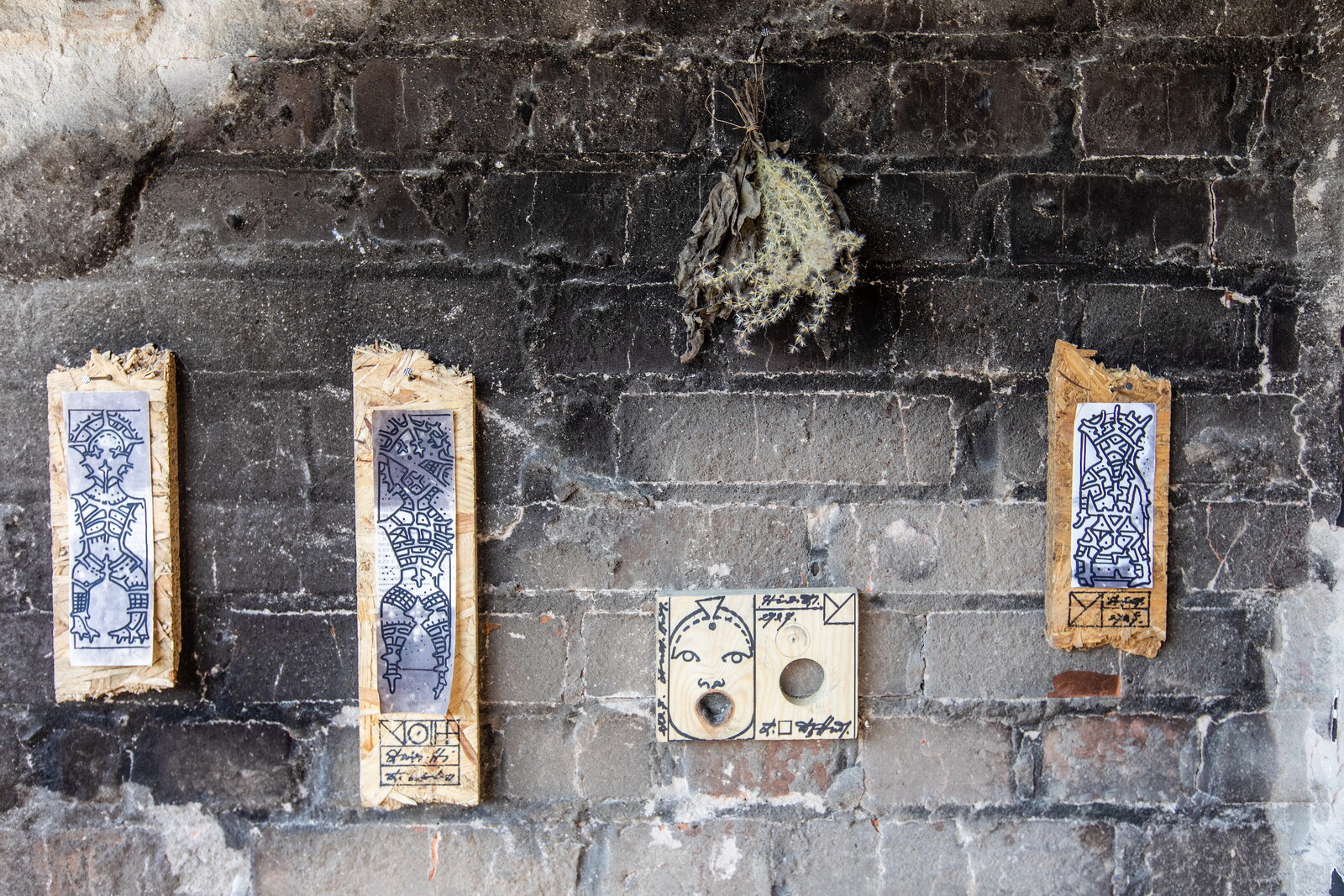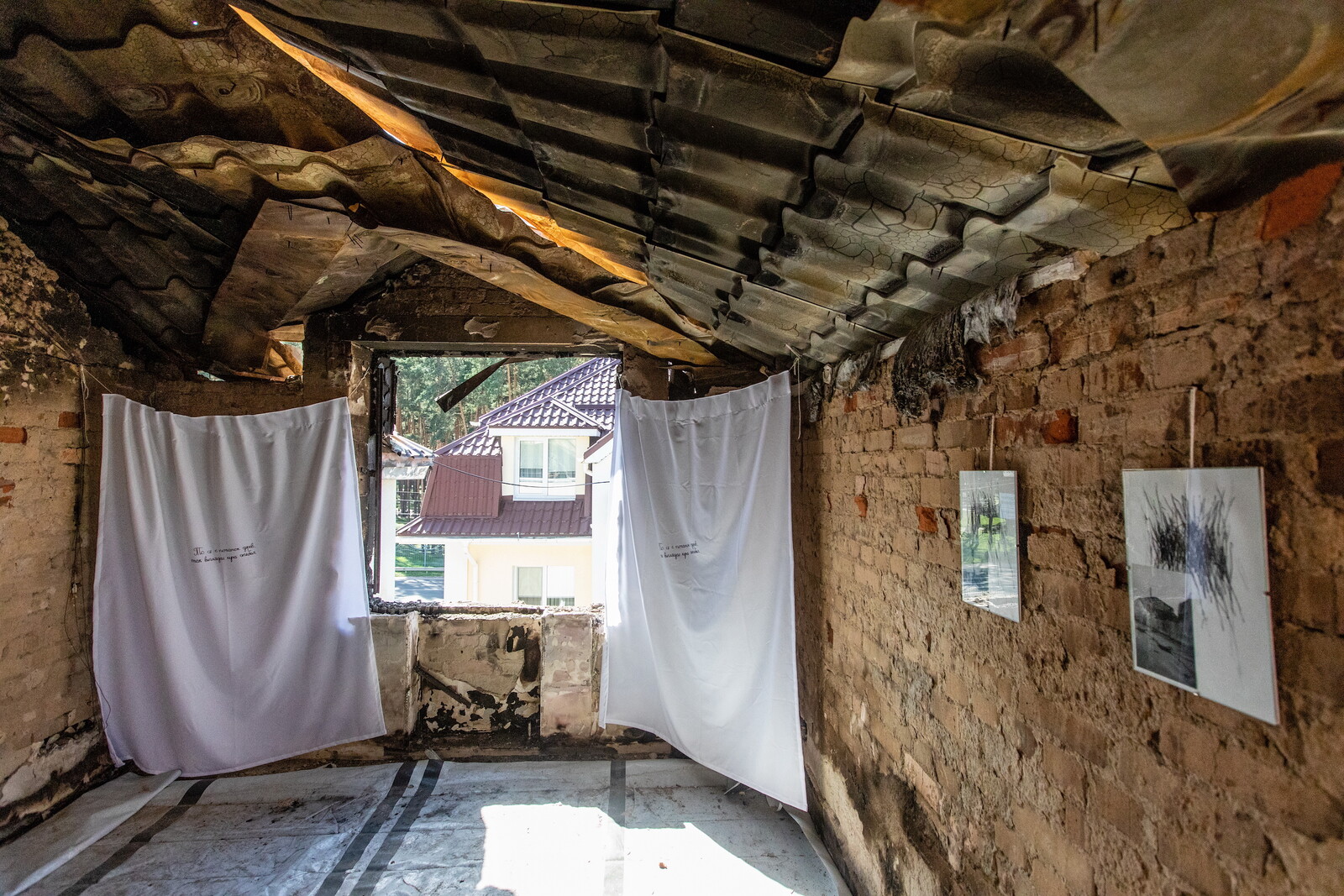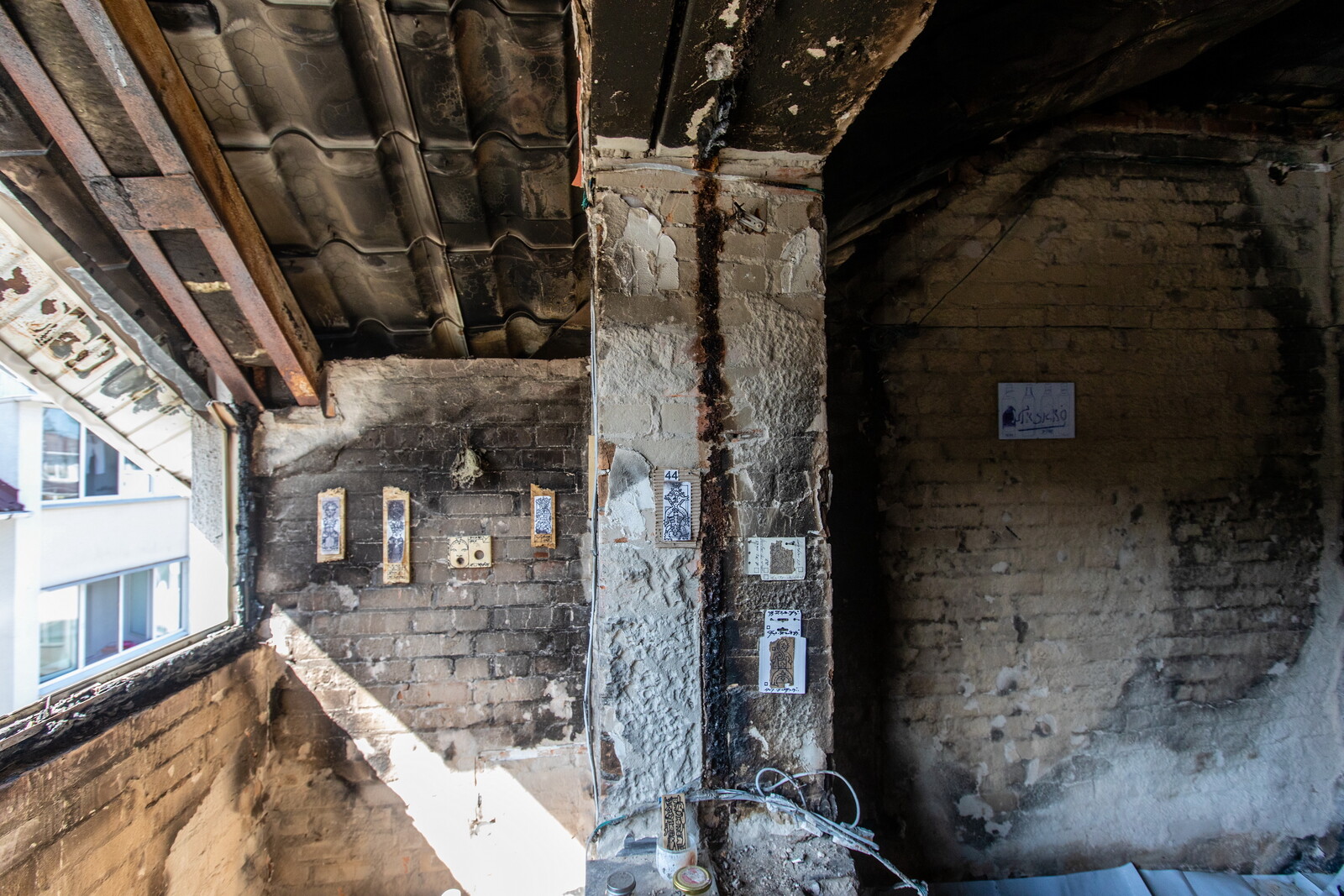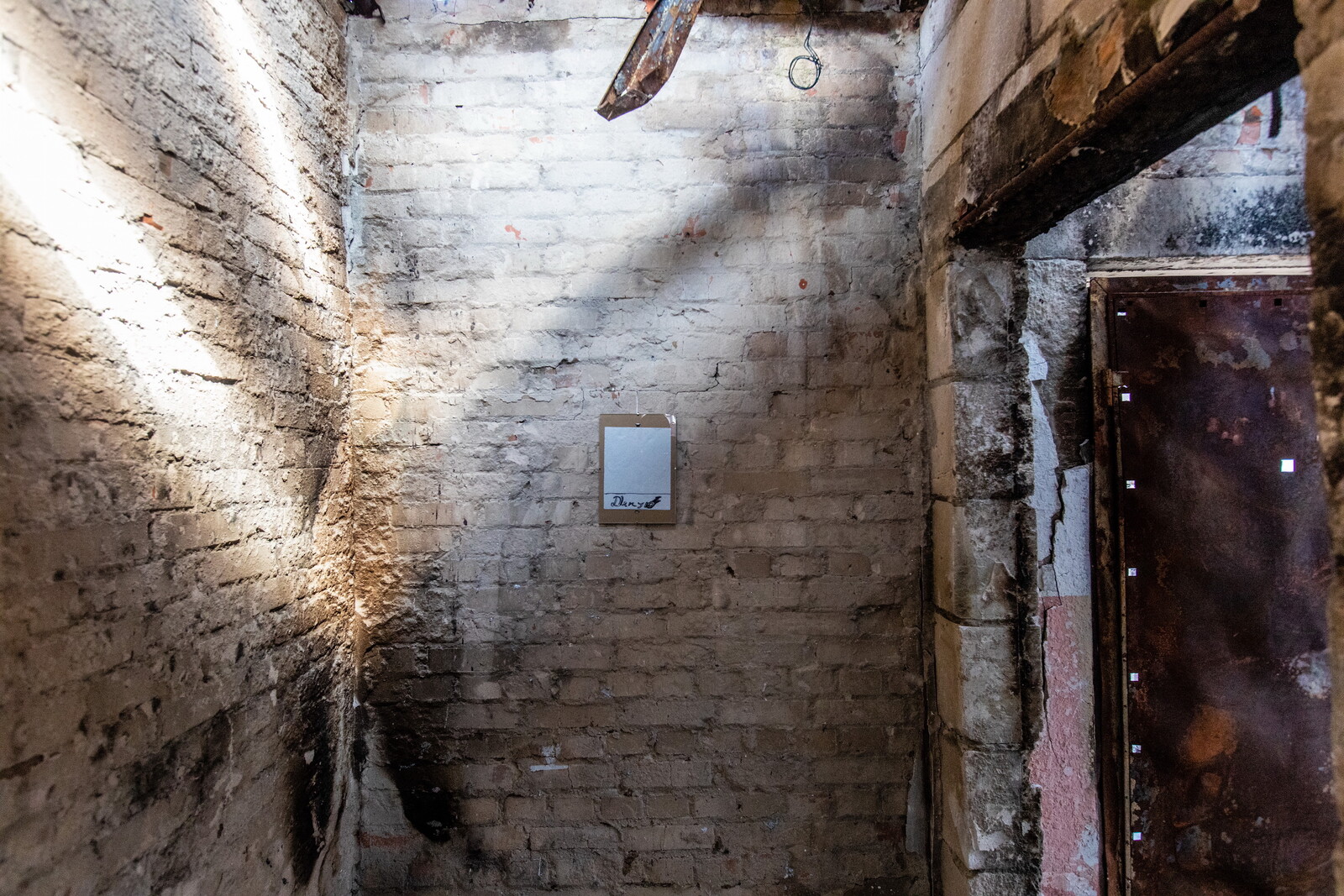On March 18, a few days after the writer and curator Kateryna Iakovlenko left her hometown of Irpin in Kyiv Oblast, she learned that her apartment had been hit by a rocket. In August, having returned to the city, she organized an exhibition in what remained of her home. Titled “Everyone is afraid of the baker, but I am grateful,” the show featured work by Katya Buchatska, Mark Chegodaiev, Sasha Kurmaz, Roman Mykhailov, Anatol Stepanenko, Stas Turina, Tamara Turliun, and Anna Zvyagintseva. In this conversation over email, she tells us how the project explored the possibility of articulating trauma, the role of archives, and what it means to live after ruins. Not least, she draws attention to the many artists in Ukraine who have continued to work through the invasion of their country, and in resistance to it.
art-agenda: How did you learn that your apartment had been ruined, and why choose to make an exhibition in the space when you returned to Ukraine?
Kateryna Iakovlenko: Six days after I arrived in Vienna, I saw a report that the remnants of a rocket had hit our building. I learned from my neighbors’ posts on social media that it had burned down. Of course, I wanted to believe otherwise, but an image of the house was sent to our joint Viber chat. There was no doubt: this was our house. I saw this destruction through social media, like all of us who follow the news. But this time, I knew every corner of that house. I had arranged the furniture, and a few days before the full-scale invasion, I had bought a new table for my kitchen, planning to make repairs there in the spring. I felt all the materiality of the loss. The importance of materiality, its dependence on violence, and its place in history are essential questions that strike me at the moment.
I came home for the first time for one week at the very beginning of June. I went into the apartment and saw everything with my own eyes. It didn’t look anything like what you see now in the photos. To get to the apartment, we climbed over the parapets because the collapsed roof lay directly on the stairs. Nothing remained of my furnished apartment, books, art, and vinyl records. It was all a pile of ashes, and everything fell apart as soon as I picked it up. I had the impression that I was walking through my own cemetery. Some things survived, but mostly things that were not so important to me before.
On my way back to Vienna, I wrote an essay about the experience.1 I wanted to name it, unpack this ruin, at least for myself. It worked, but not completely. I wanted to talk about this experience, to see it from another side. The exhibition was another critical form. The apartment itself is already a bright visual statement. Before I arrived, our house was cleaned by volunteers from Drahobrat, one of the initiatives that help residents of the Kyiv region with destroyed homes. Therefore, when I came home the second time, the walls were empty, but this space was still filled with something difficult to name. When I thought about mounting an exhibition, I didn’t want to make it exclusively about loss and tragedy. I wanted to talk about the filled void, what loss is, and what its fate is in the future, so one of the show’s topics is life after ruin, life after death.
This exhibition is not about unequivocal answers but rather about questions and questioning. What are we to do with ruins; what are they ultimately? What is my attitude and relationship to this?
AA: How are those concerns about community and recovery reflected in your choice of title, “Everyone is afraid of the baker, but I am grateful”?
KI: This title has two themes at once. The first is related to the gratitude I feel for all Ukrainians. The grassroots solidarity, which emerged in the first days of the war, could not help but inspire and empower. I was amazed at how my once-apolitical neighbors suddenly started making Molotov cocktails in their basements and preparing to meet the Russians. Irpin immediately turned out to be a hotspot; from the very beginning, we could hear explosions and anti-aircraft fire; my house shook when bridges were destroyed. But people made their choice: they were preparing for defense. As a result, we experienced collective fear, collective hate, and collective love. And this is the most beautiful feeling of unity.
On Monday, February 28, a friend and I went to the supermarket for groceries. We stood in a long line on the street, and inside the supermarket, there was a separate long line for bread. Three loaves of bread were handed out to each person. Everything was languid. Extraneous sounds were very stressful because everyone understood they had to be careful. But in line for bread, everyone became very close; we did not chit-chat but had deep, interesting conversations. However, someone began to complain that everything was taking so long, and the baker said he was traveling in from a neighboring village, which was already occupied. It was dangerous, but he did it.
In March, I was asked to write a diary for an Austrian newspaper, and later I was asked to read it in Berlin as a performance. But one of the organizers said this story about the baker was too sensitive, and maybe the German audience wouldn’t be able to stand it—it’s too painful for many Europeans, because they believed this could not happen again. But to me, this story is not about pain but about care and solidarity.
In my apartment exhibition, there were three drawings by Stas Turina from the series “Thank you” (2022). This is his gesture of gratitude and solidarity. He writes the word “Thank you” in Ukrainian on pieces of paper and distributes them to people. For the exhibition I used three paper napkins with such signatures. As a person who researches art history, in this context, I can draw parallels with Art Brut, talk about hierarchy and power structures in art history, and about the rejection of the concept of masterpieces. But Turina’s work is about finding one’s position and caring. It is also about the search and the power of the word.
AA: The exhibition focuses on expressions of gratitude and mutual aid among residents rather than anger against the aggressors. Was it a conscious decision to focus on the solidarity of your community?
KI: Of course, like many Ukrainians, I feel rage and disappointment towards the aggressor.2 But most importantly, I feel indifferent to him. For me, it is only necessary that there are no Russian soldiers on the territory of my country, that there is no Russian propaganda, that there are no more explosions, and that children do not cry from the sirens. I don’t want to think about the aggressor; I like to think about the future, about ordinary people experiencing all this with me.
Yes, I have a lot of anger, but this anger is a natural reaction to the lack of justice. I am waiting for this justice, and until it is established, I see it is necessary to speak about those who suffer unjustly. I think about minorities and women, old people, and children. I think about those regions that have been occupied, and I am waiting with their residents for the moment of liberation. Always before my eyes are strong images of mutual support. For example, when a policewoman took the hand of a man in Kharkiv city who was crying near his son’s dead body. I don’t have children, and I can’t imagine what it’s like to lose a child, but I can share this loss; I can imagine myself in the place of this woman who lent a helping hand. I would like to believe that my works are the same support hand. All I want to do now is hug all Ukrainians and share my solidarity, dignity, and care.
AA: One of the sections in the exhibition considers the role of archives. How important do you consider art to be in documenting the war and preserving the memory of freedom?
KI: Archives are critical. If the archives were not so essential, the Russian embassy in Ukraine would not have burned its archives the day before the war and its army would not have taken aim at museums and cultural institutions.3 I have worked a lot with the history of Ukrainian art, which is full of lacunae, unproven myths and oral stories; for me, these spots and irregularities are essential. I am interested in looking at those who were in the shadows and why. But today, the question of absence has arisen from a different angle: what does absence mean historically, is it a process of proper selection, and who made it? What fills this absence?
AA: How do you characterize those art-historical blind spots in the Ukrainian context, and how can its art history be revised to shine a light onto them?
KI: Researching the history of Ukrainian art, as a person who turns to feminist epistemology, I cannot but emphasize that absence is the result of the violent, brutal policy of the empire, the effects of patriarchal structures, and the structural and all-encompassing violence that exists. Therefore, documenting the war in Ukraine is important because it is an element of protection, an opportunity to write our history by ourselves.
Consequently, I am for the existence of multiple versions of archives, documenting images and written or oral testimonies, even dreams—as is done by the Center for Urban History in Lviv.4 For example, I have already mentioned the importance of local social networks in the war, such as Telegram and Viber chats; looking into them means preserving all this evidence of grassroots resistance. In his poem “U Boha za dveryma lezhala sokyra” [Behind God’s door lay an ax, 1848], the iconic Ukrainian writer Taras Shevchenko uses the image of an ax to show the Cossack’s struggle with Russian empire. Today I may interpret this image as an image of grassroots fighting tactics against a violent invader. Usually, this ax was lying near the door; therefore, when the enemy broke into his private territory, the owner of this house could use it quickly to protect the household. It is essential to talk about the culture of grassroots resistance strategies of Ukrainians, and social networks and the internet were an ax for all of us in the first days of a full-scale invasion. And it worked out.
AA: Another chapter reflects on “life after the ruin.” What role do you think artists have in reconstructing Ukraine, and how has the country’s cultural identity been changed by the war?
KI: This is a challenging question. I do not think the answer already exists because the war is not over yet. You and I are having this conversation at a very emotional and dynamic moment when many things are changing, on both the physical and cultural battlefields. The experience that existed in the first month of the war differs from today, but we have not yet won the war; we have not survived all the losses.
Identity is an interesting issue, but I would not talk about just one identity; our identity lies in its multiplicity and variability, and losing one of its parts means vulnerability for its other components. Generally, I stand on an intersectional approach to identity and believe it is built by many factors. And that’s why the industrial context and life in the Luhansk Region during the 1990s strongly impacted my identity, political position, and understanding of who I am. I am also a supporter of the fact that a person can choose their identity, and no one has the right to discuss these choices. So the question of identity is currently based on bodily, political, gender, and social contexts and freedoms. We are also rethinking all these relationships and interconnections.
My colleague, the art historian Asia Bazdyrieva, rejects the concept of identity: she calls it a new Ukrainian subjectivity. When I was in Kyiv in the summer, I talked with an artist, Yaroslav Futymskyi, about identity as a concept and how to talk about it today. The problem is that we are currently using a vocabulary borrowed from modernity and looking for answers in the past. But we are thinking about the future and creating the future. Indeed, this war is also a remnant of modernism, an attempt to conquer territories and resources, and the desire to show power instead of solidarity and dignity. Unfortunately, we don’t have a dictionary to explain what is happening with us now, nor to define what identity is today. But we feel it differently than before the war. Every time I fill out documents to identify myself, there are very rarely any answers that I can choose. So often, the best option is “Other.”
But, most importantly, the issue of identity in the context of war leads away from the primary problem: it is Russia who attacked Ukraine, it is Russians who are killing Ukrainians, and to justify their actions, they turn to fabricated concepts of language and identity. We must stop talking about identity and give space to create something completely new.
AA: Katya Buchatska’s work is inscribed “One journalist asked how the war affected my creativity.” The issue of an artist’s responsibilities during wartime is as old as history. How do you understand the role of artists and curators to have changed in the context of Ukraine’s resistance?
KI: When asked how the war has affected art, I don’t know where to start. First, we must consider the destruction of museums and cultural centers and the transfer of art and institutions to safer territories. What does it mean to move a local museum, whose narrative is built on local knowledge and histories? Shall we talk about how the practice of artists who hid in the basements and bomb shelters of Mariupol or lived through the occupation in Kherson changed? Or about the practice of artists who went to the front to protect their relatives? Do they still have the ability, time, and resources to produce work, or is their very resistance an artwork?
The war changed everything. It undermined old standards of ethics, aesthetics, materiality, value, and significance. These all give us space to recall art and artworks. Do we still prepare places in museums for new objects that should somehow convey our transgressive experience? What kind of art can express these incredible and contradictory emotions, enthralling, inspiring, and provoking? What is provocative and political art today?
In July, Detenpyla gallery in Lviv conducted an exhibition entitled “Getting used to being a bee” by Lubomyr Sikach. There were shovels, axes, and other objects that resembled agricultural implements, with one difference: parts of these objects are made of glass. On the one hand, this is a continuation of Shevchenko’s idea about the ax lying at God’s door; on the other hand, it is about the fragility of this grassroots struggle and culture, which can be broken and damaged in an instant. Today we can receive lots of exciting and different artistic experiences, all inspiring and fascinating. But still, we all have to remember that lots of works were not produced or destroyed because of war.
AA: Can you tell our readers a little bit more about how specific artists in Ukraine are responding to the situation?
KI: At the beginning of the full-scale invasion, the artist and photographer Yulia Krivich, who now lives in Warsaw, co-organized the Solidarity House of Culture Słonecznik, a platform for discussions, exhibitions, and other events. Krivich is one of the most active advocates of Ukrainian culture in Europe. Her current practice was deeply affected by the war; it inspired many. And I believe her activism is crucial not only for Ukraine but also for the Warsaw community.
Almost every day, the artist Inga Levi creates a new work in her graphic series “Double exposure” to capture the mundanity of war. On the one hand, her drawings talk about war; on the other hand, they tell about some very ordinary things that are not related to the war. Levi was supposed to open a solo exhibition in March at depot12_59, an apartment gallery organized by artist Tamara Turliun. But unfortunately, due to the full-scale invasion, these plans were not realized.
Artists Stas Turina and Katya Libkind have constantly reflected on the war, but most importantly they engaged in volunteering for the evacuation of artists with and without Down syndrome, and created workshops in a psychoneurological dispensary.
In the first days of the war, Kinder Album, an artist from Lviv, created reflective and very vibrant graphics; now, she has discovered a new form for herself and creates porcelain sculptures. By reproducing bones and skulls in such a delicate material, she problematizes ethics and aesthetics in the context of war.
Speaking of powerful and emotional testimonies of war, I must mention works made by Kateryna Lisovenko, Dana Kavelina, Sana Shahmuradova, Alevtina Kakhidze, and Vlada Ralko. The value of works by Daniil Nemyrovsky made in the Mariupol bomb shelter is incredibly unspoken. Hiding from shelling, he portrayed people who were forced to be in the same space with him. When he escaped from Mariupol, he was able to take only three of his drawings.5 And drawings by Anton Saienko reflect the way the war has shaped our landscape, and our desire for freedom. Another important series of painted landscapes were made by Lusia Ivanova, who depicted the dreams of her friend on the frontline: working with a thermal imager, he started seeing dreams in such colors. In her paintings, Ivanova reflects on this transformed visuality due to the war experience.
Reflecting on the war and the reproduction of Russian imperialism, the artist Anna Zvyagintseva created a “sustainable” costume for the invader, which he could use in subsequent wars. If he died, he could be buried in it, because there are a lot of plant seeds inside the suit. The irony in her work borders on pain, anger, and care; it is a powerful desire for protection and safety for her loved ones. Some of them are at the frontline.
Furthermore, there is an essential and vivid reaction to the war from institutions and self-organized initiatives. Many of them shifted their focus and interests to social projects. For example, Dnipro Center for Contemporary Culture; one of their projects is the kitchen community project, which conducts therapeutic conversations with displaced people through discussions about food and cooking; they see lots of connections with culture, imperialism, economy, and power, which are currently relevant. It is very interesting to see how the artistic infrastructure has been changed and how important it has become to places far from Kyiv, such as Ivano-Frankivsk and Uzhhorod. And how visible and strong today small institutions such as, for example, Assortymentna Kimnata.
Since the full-scale invasion started, the Ukrainian Emergency Art Fund aims to document, archive, support, and conduct exhibitions abroad showing the most recent art.6 In my opinion, it is complicated to sum up or make any conclusions at the moment because this art is still being formed.
Whenever I list examples of artistic practices, I want to remember all the current projects because they need attention and should be mentioned. And I feel sorry when there is no chance to discuss more names and practices. For many years, Ukrainian art was excluded from an international perspective only because there was no interest; there was little representation in museums and archives. Ukrainian artists deserve to be highlighted not only because of the war but also because their art is compelling, touching, and critical.
AA: What do you plan to do next?
KI: The answer is simple. We will continue our everyday work because, in fact, the most challenging job will start after the war. It will be difficult, especially in the arts and culture field, so we must be ready for it. We are waiting for the process of restitution from Russia to bring stolen art back home; for reparations, including for lost art objects, museums, and architecture; we are waiting for fair and respectful representation in the international context and solidarity from other cultures. So we have a very long to-do list, which is perhaps very difficult to manage for even one lifetime, but we have it for one day. But most importantly, we must survive, because the war is not over yet, and many Ukrainian artists and cultural workers are still at risk. Just a few days before I write this, a leading ballet artist died on the front line.7 Nothing is outside of politics and the war, especially arts and culture.
Kateryna Iakovlenko, “Poppies and Hedgehogs,” Apofenie (June 12, 2022), https://www.apofenie.com/letters-and-essays/2022/6/10/poppies-and-hedgehogs.
Kateryna Iakovlenko, “Ukrainian Rage,” e-flux Notes (May 11, 2022), https://www.e-flux.com/notes/468104/ukrainian-rage.
Evan Hill, Brenna Smith and Dmitriy Khavin, “Videos show burning of documents in a Russian consulate in Ukraine,” The New York Times (February 22, 2022), https://www.nytimes.com/2022/02/22/world/europe/videos-show-burning-of-documents-in-a-russian-consulate-in-ukraine.html.
“Collecting War Diaries and Dreams,” Center for Urban History (April 11, 2022), https://www.lvivcenter.org/en/updates/war-diaries-2/.
Kateryna Iakovlenko, “These people survived Mariupol. Here are their stories,” openDemocracy ( April 8, 2022), https://www.opendemocracy.net/en/odr/ukraine-russia-mariupol-survivor-stories/?source=in-article-related-story.
Elizabeth Blair, “Ukrainian ballet dancer Oleksandr Shapoval is killed on the battlefield,” NPR (September 15, 2022), https://www.npr.org/2022/09/13/1122659509/ukrainian-ballet-dancer-oleksandr-shapoval-is-killed-on-the-battlefield.





